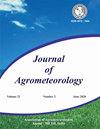纤维作物大麻(Cannabis sativa)和棉花(Gossypium hirsutum L.)需水量和水足迹的比较研究
Q3 Agricultural and Biological Sciences
引用次数: 0
摘要
水是一种宝贵而有限的资源,由于气候变化的影响和农业的过度利用,水正面临越来越大的压力。棉花是纺织品中使用的主要天然纤维,是一种高度耗水的作物,因此造成农业用水对环境的负面影响,例如生态系统和其他用途的耗水、土地退化和污染物的传播。因此,人们对建立需水量较低的替代天然纤维来源非常感兴趣。大麻纤维正在成为一种越来越受欢迎的纤维替代品,据称在种植过程中需要更少的水。因此,本文的数据与先前发表的28个来源进行了比较,发现与棉花相比,大麻的作物需水量(CWR)低38%,水足迹(WF)低60%,作物灌溉需求(CIR)低84%,灌溉水足迹(IRF)低91%。因此,这些结果支持大麻作为一种节水环保可持续替代棉花纤维种植。本文章由计算机程序翻译,如有差异,请以英文原文为准。
Comparative study of water requirements and water footprints of fibre crops hemp (Cannabis sativa) and cotton (Gossypium hirsutum L.)
Water is a valuable and limited resource, which is becoming increasingly under pressure due to the impacts of climate change and over utilization by the agricultural industry. Cotton is the predominant natural fibre utilized within textiles and is a highly water-intensive crop, thereby contributing to the negative environmental impacts of water use in agriculture, such as depletion of water from ecosystems and other uses, land degradation, and dissemination of pollutants. Accordingly, there is significant interest in establishing alternative natural fibre sources, which have lower water requirements. Cannabis sativa (hemp) fibre is becoming an increasingly popular fibre alternative and is purported to require less water during its cultivation. Accordingly, herein data was compared across 28 prior published sources, which identified that hemp has a 38% lower crop water requirement (CWR), 60% lower water footprint (WF), 84% lower crop irrigation requirement (CIR), and 91% lower irrigated water footprint (IRF) as compared to cotton. Therefore, these results support hemp as a water-efficient environmentally sustainable alternative to cotton for fibre cultivation.
求助全文
通过发布文献求助,成功后即可免费获取论文全文。
去求助
来源期刊

Journal of Agrometeorology
农林科学-农艺学
CiteScore
1.40
自引率
0.00%
发文量
95
审稿时长
>12 weeks
期刊介绍:
The Journal of Agrometeorology (ISSN 0972-1665) , is a quarterly publication of Association of Agrometeorologists appearing in March, June, September and December. Since its beginning in 1999 till 2016, it was a half yearly publication appearing in June and December. In addition to regular issues, Association also brings out the special issues of the journal covering selected papers presented in seminar symposia organized by the Association.
 求助内容:
求助内容: 应助结果提醒方式:
应助结果提醒方式:


